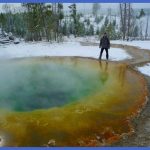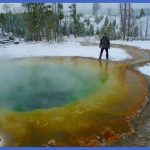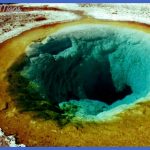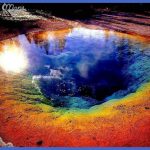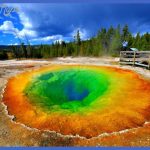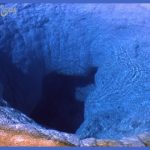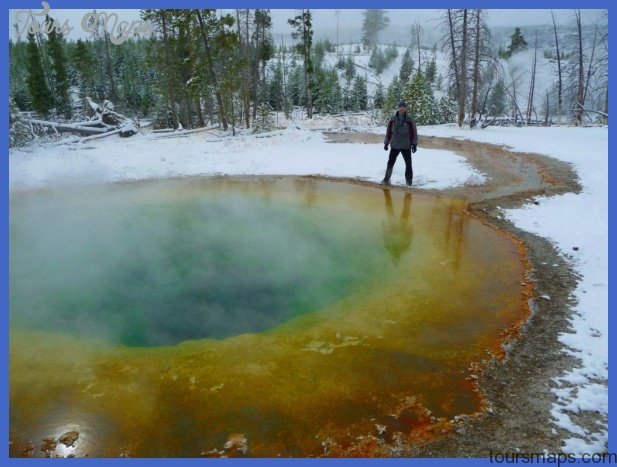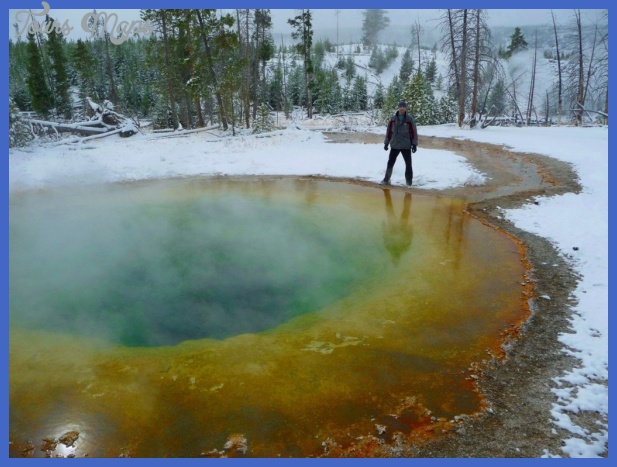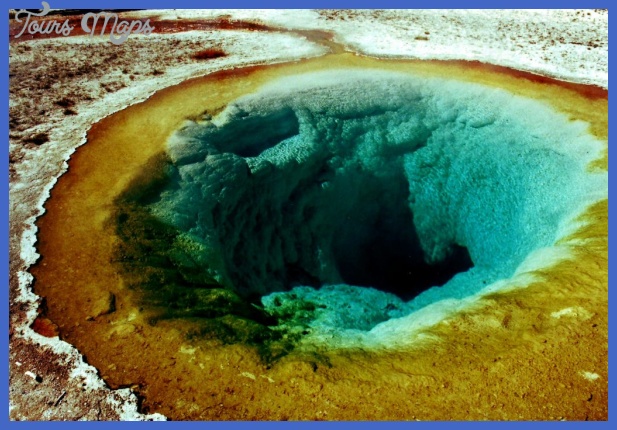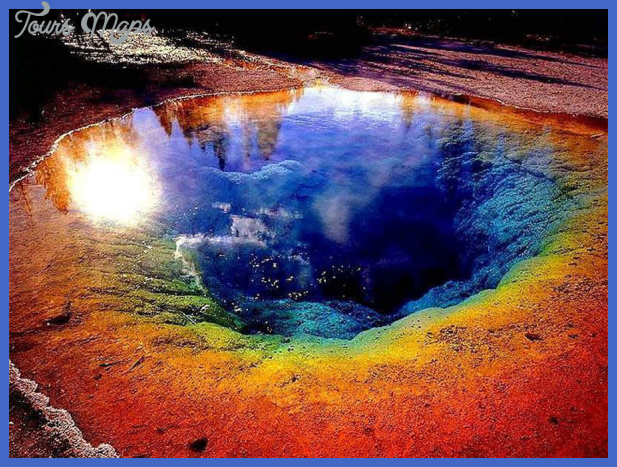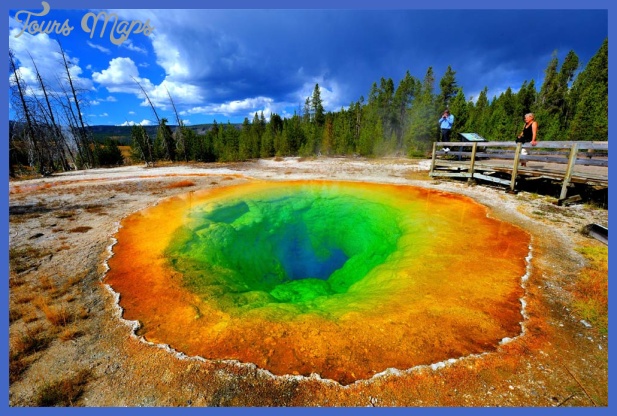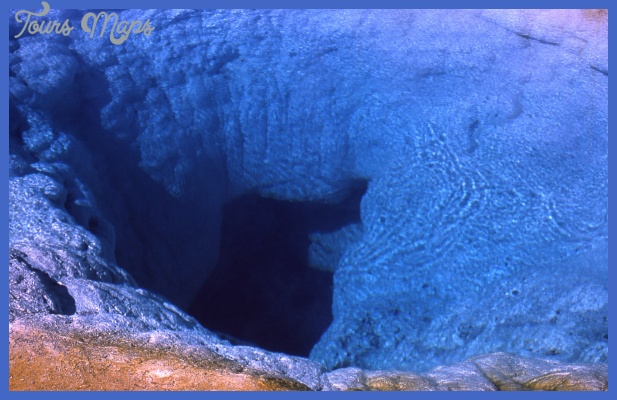Across the river from Seismic and from the trail, another very short-lived geyser, called Fantail Geyser for its angled eruptions, performed impressively for one spring and summer (1986), then almost not at all since. Beyond Atomizer, you’ll find oblong Gem Pool, which overflows constantly. East of Gem Pool and across the trail is Bear Den Spring, where, in spite of bubbling water at the bottom, a crawl space under the rock ledge served at least once (in 1958) as a bear’s winter home. After descending the hill, look toward the west (left), where Baby Daisy Geyser may be steaming. A smaller version of Daisy ( 101), Baby Daisy began erupting 30 or 40 feet high (9-12 m) about every three-quarters of an hour early in 2003 and continued through 2004. Farther along and close to the trail, you reach pale sapphire blue Mirror Pool, with yellow to brown bacteria around the edges. Finally, you pass Cauliflower Geyser south of the small footbridge before you reach the highway. The cauliflowers are the same type of formation as the biscuits of Biscuit Basin, but bigger. They are nodules of geyserite. At the footbridge near Cauliflower Geyser, a trail leading north parallels the Grand Loop Road to join the Mallard Creek and Fairy Falls trails about 2 miles (3.2 km) from Biscuit Basin.
Geyser Route One features you may have missed As you return from Morning Glory Pool, you’ll have the chance to see a few hot springs and geysers you missed if you took the recommended side trails on the way out. Three stretches of the main trail are described below in sections labeled (A), (B), and (C). These letters correspond to labels on the Upper Geyser Basin map, 83. (A) After recrossing the bridge over the Firehole near Fan and Mortar geysers, continue straight ahead (unless Riverside Geyser is about to erupt, in which case, don’t miss it!). Here you’ll pass the Chain Lakes Complex, which consists of several hot springs and geysers related both to each other and to the Grotto Complex. The Bottomless Pit was described by the geologist Albert C. Peale of the 1878 Hayden Survey as a beautiful blue cavern-like spring of great depth. Link Geyser has recently had eruptions up to 100 feet (30 m) high. Culvert Geyser has an interesting story. Road engineers building the original Grand Loop Road (now the walkway) buried one spring nearby and built a culvert around this one. This gave Culvert Geyser the energy to enlarge its crater and begin spouting to 2 feet (0.6 m), which it continued to do for some years. It now has a green center, bright orange edges, and a prominent overhanging edge. (B) Between Grand Geyser and Sawmill Geyser, the straight walkway has only three small springs.
Bulger Spring (on the right as you walk toward Old Faithful Village) is actually a small geyser. The seemingly unremarkable springs on the left are interesting because they are not connected underground, according to geyser expert T. Scott Bryan, although their apertures are only 1 foot (0.3 m) apart. Crystal Spring, named for its very clear water, is connected to the Grand Geyser Complex, but Crystal Spring’s Geyser (a round hole very near the edge of Crystal Spring’s runoff channel) is a member of the Sawmill Complex. (C) Back on Geyser Hill. When the boardwalk splits near North Goggles Geyser, turn left to take the upper part of the loop and see the features you missed at the start of Geyser Route One. Ear Spring is obviously named for its shape and used to be called the Devil’s Ear. Haynes Guide in the 1920s reported that it not only resembles an ear in shape, but the lobe is pierced and the earring is a tiny geyser. It is here that messages are transmitted, so the story goes, to regions below. Sometimes Ear Spring’s water becomes superheated (hotter than boiling), and bubbling occurs around its rim. The western end of the trail to Solitary Geyser and Observation Point joins the main boardwalk between Ear Spring and nearby Beach Spring. In rainy summers, the meadow north of here is filled with wildflowers.
Beach Spring in the boardwalk’s corner may get its name from the beachlike terrace over which its water intermittently flows, from the sandy color of the sinter in its central bowl, or perhaps from the sound it makes during boiling periods: like surf at a beach. If you watch for a few minutes, you may be hypnotized by seeing the water rise, bubble, and fall repeatedly a short way down in the bowl. Aurum Geyser, whose name means gold in Latin, gets its color from iron oxide inside its tiny geyserite mound. Aurum erupts for about 1 minute at intervals varying from about 3 to 12 hours, with the more frequent intervals in winter and spring. Sometimes it sprays the boardwalk with spurts up to 25 feet (8 m) high. Notice the large and uniform gey-serite eggs in Aurum’s overflow pool. Aurum’s bubbling and erupting causes geyserite eggs to form. Doublet Pool was called The Quaker by 19th century tour guide, George Henderson. Standing near it, you can sometimes hear and feel vibrations, probably caused by the collapse of steam bubbles within the pool. Its overhanging geyserite ledge is unusually wide and thin (and dangerous!), and you can see other ledges partway down, indicating previously lower water levels. Sponge Geyser is barely a geyser at all, but it may have been one in the past or at least has been building its cone for a very long time. It resembles a sponge both in its highly perforated surface and its light beige color. When active, its water boils up to the rim, then sinks out of sight. Pump Geyser and two small vents nearby called The Pump can be counted on to splash more or less vigorously almost without a break.
They do sound very much like pumps. Giantess Geyser rests in a deep pool high atop Geyser Hill. The boardwalk is placed a safe distance away, because when the geyser is active, it can erupt as high as 200 feet (60 m) with very little warning. Giantess is surely the queen of the hill, with influence over many other springs and geysers; her eruptions are known to affect Vault, Teakettle, Infant, Giantess Geyser, September 5, 2001 Sponge, Doublet, Beach, Ear, Plume, and Beehive. Early writers who saw Giantess erupt described globular masses of vapor that were domed at the top like a crystal cupola. Steam phases, which can alternate with water phases, make a deafening roar that may be heard a mile away. Eruptions can last many hours one induced by the 1959 earthquake lasted over four days. However, their rarity (an average of three per year since 1984) means that you’ll have to be very lucky to see one, as was Nathaniel Langford, who named it in 1870. Closer to the boardwalk are deep-welled Teakettle Spring, the punchbowl-shaped crater, and Vault Geyser. Teakettle Spring is an excellent example of how springs change with time. Until 1947, its crater was full to the rim. Now the water level sits deep out of sight, but the bubbling from inside still sounds rather like a teakettle. Some of Vault Geyser’s eruptions occur after Giantess starts and may go to 15 feet (4.5 m), but it can erupt independently of Giantess. An unusual attribute of Vault is that it erupts from far below ground level rather than first filling its crater, as most geysers do.
Active once or twice a month, Dome Geyser sits high up the hill to the east. Twin craters in the shape of butterfly wings nearby (but out of sight of the trail) belong to Butterfly Spring, which surprised observers by bursting out in major 30-40-foot (9-12 m) muddy eruptions but only during May 2003. Infant Geyser sometimes has tiny eruptions when Giantess Geyser is active. Note its oval cavity with an unusual deep red lining and cloudy, acidic water.
Yellowstone Morning Glory Pool Photo Gallery
Maybe You Like Them Too
- The Best Cities To Visit in The World
- World’s 10 Best Places To Visit
- Coolest Countries in the World to Visit
- Travel to Santorini, Greece
- Map of Barbados – Holiday in Barbados

